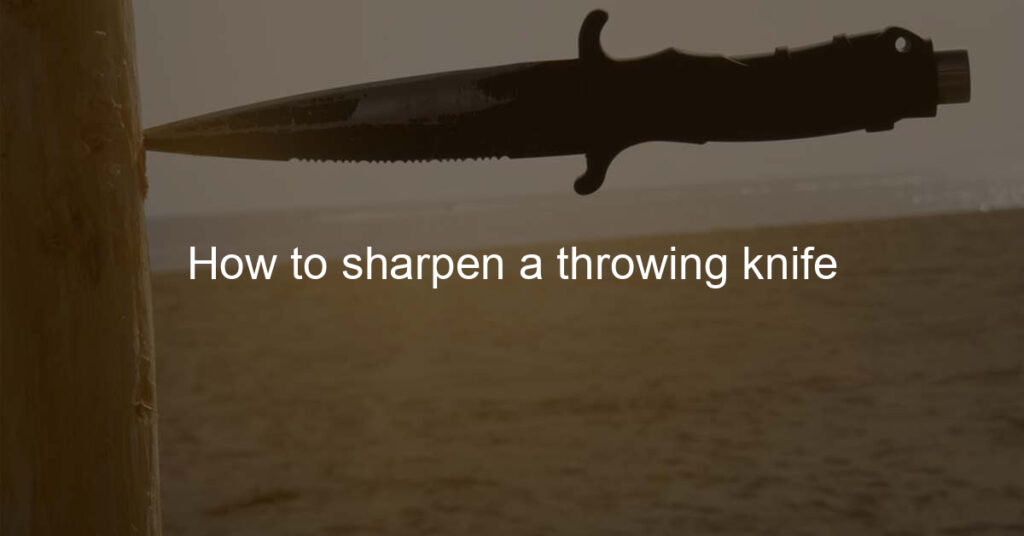If you’ve ever thrown a knife, you know how important it is to have a sharp blade. A dull knife won’t stick in the target and can be dangerous to throw. In this post, we’ll show you how to sharpen your throwing knives so they’re always ready for action.
What are the best methods for sharpening a throwing knife?
Throwing knives can be great fun, but to ensure that you get the most out of your throwing session it’s important to keep them in good condition. The best methods for sharpening a throwing knife depend on the material that it is made from. For blades made from high-carbon steel, you should use a honing stone or professional-grade sharpening tool.
Knives fashioned from stainless steel will require visiting a professional since they need a more precise level of sharpening. There are also alternative techniques using sandpaper that allow you to sharpen knives at home. Whatever the method, make sure to protect yourself with safety gear and take caution when sharpening any kind of blade.
What kind of sharpening tools do I need for my throwing knives?
If you’re looking for a good sharpening tool for your throwing knives, then you have a lot of options to choose from. A whetstone is a great choice because it’s small, portable, and easy to use. You can also invest in an electric sharpener for more precision, or grab some lighter grit sandpaper if you want to get the job done faster. Just be sure to always read the instruction manual carefully before using any new tools – that way you’ll prevent any accidents and make sure your knives are as sharp as possible!
How often should I sharpen my throwing knives?
Throwing knives can be incredibly dangerous and should never be taken lightly, but they can also be a blast with the right handling techniques. When it comes to sharpening your throwing knives, you’ll want to make sure they’re extra sharp so they don’t miss their intended target. Generally speaking, you should sharpen your knives once every four weeks or so depending on how often you’re using them.
Make sure to take the time to properly sharpen them for your safety as well as for the accuracy in aiming. Running your finger along the blade should give you an indication of its sharpness, ensuring that every knife is at its optimal sharpness and ready when it’s time to throw!
What is the proper angle for sharpening a throwing knife?
When it comes to sharpening your throwing knife, finding the perfect angle is essential for having an accurate throw. The most common advice is to keep the blade at a 25-30 degree angle coming from the side of the handle. But this isn’t always enough; you’ll need to analyze how the blade interlocks with your throwing motion and how it affects accuracy.
By experimenting with angles by test throwing in a controlled environment, you can find out which angle works best for you and hone your skills over time. Don’t forget that safety always needs to come first when sharpening your knife so wear protection and ensure any area you are working in is secure before anything else!
How do I know when my throwing knife is sharp enough?
Throwing knives are versatile tools that can be used for activities like hunting, target practice, and more. But if you want accuracy in your throwing knife use, you’ll need to make sure it’s sharp enough first. Unfortunately, there’s no single answer to the question of how sharp is sharp enough for throwing knives.
It depends on the type of blade and its intended purpose – so a kitchen knife may require a much sharper edge than one used to take down a game or a zombie! Generally speaking though, when it comes to testing the sharpness of a throwing knife, running a finger along the blade should indicate how well it’s been sharpened. If you feel any tugging or roughness as your finger skims across the blade, chances are you’ll need to sharpen it some more before it’s ready for use.
What is the secret to knife throwing?
Knife throwing looks effortless when done correctly, but there’s a lot that goes into it! For perfect accuracy and minimal risk, aspiring knife throwers should focus on honing in on their accuracy, technique, and timing. Taking your time to practice consistently is key; start at close range and gradually increase it over time as you hone your skills and refine your form. Stance alone can play a major role in the success or failure of a throw–you want to maintain good posture for balance and stability when you’re about to release the knife.
Additionally, applying spin to the knife before it leaves your fingers can affect its trajectory toward the target. With a dedication to perfecting both form and concentration levels, anyone can eventually learn the secret to successful knife throwing!
Conclusion
Working with throwing knives can be a fun and rewarding hobby, but only if you practice safety guidelines at all times. Sure, returning a dull throwing knife to its former sharpness is fairly simple, but it’s important never to lose sight of the potential danger that comes with these tools. Don’t let a dull blade spoil your fun by having an accident – sharpen it properly and take extra precautions while having a good time! Finally, remember to keep throwing knives separate from regular knives or blades – there are specific types of sharpeners for this exact reason that make maintaining the shape and the edge of your knife much simpler. So next time you break out the knife-throwing equipment for target practice, reach for the honing steel first – happy sharpening everyone!







